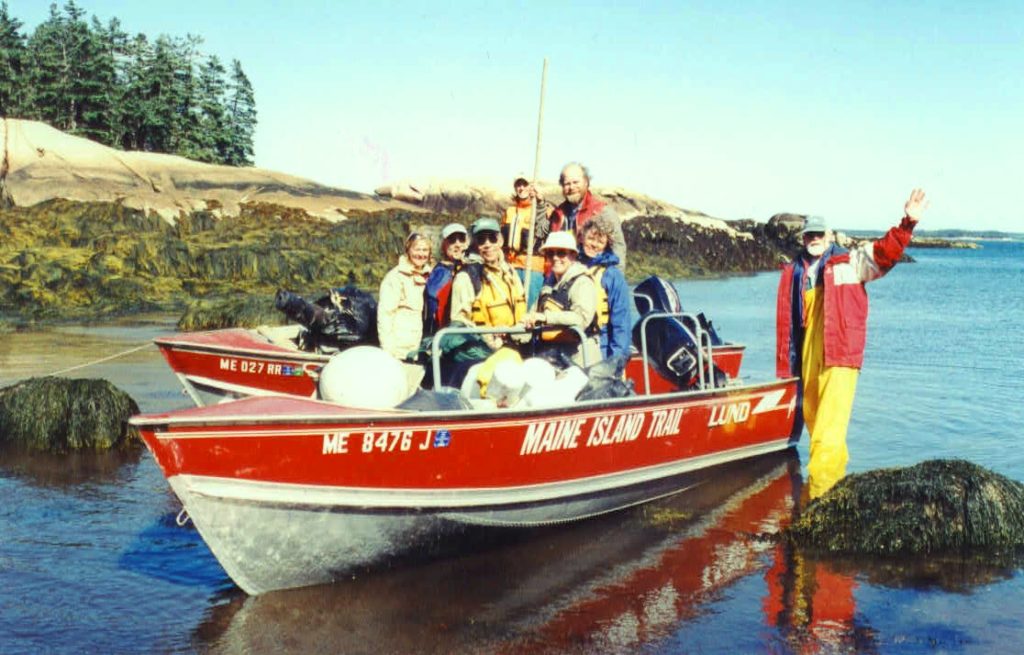Today is the 30th anniversary of the Maine Island Trail — the day in 1988 when 12 citizens met to form the Maine Island Trail Association and create “an outstanding waterway for small boats” along the coast of Maine. Since then, more than 33,000 coastal explorers and stewards have helped ensure that over 200 wild islands on the Trail remain pristine and accessible.
The Maine Island Trail is a grassroots effort launched by citizens seeking to visit and steward the wild, uninhabited islands of Maine. While friends groups exist for many public parks, there are few if any others where a simple handshake agreement between 100 disparate landowners and thousands of users and volunteers has created a nationally known recreational entity.
The idea of a coastal water trail in Maine was born in the late 1970s following a land survey conducted by the State of Maine of the uninhabited coastal islands. The survey determined that the State held title to some 1,300 unclaimed islands, rocks, ledges, and low-water bars along the coast. In the mid-1980s, the State collaborated with the Island Institute, a nonprofit organization serving the islands and communities of the Gulf of Maine, to evaluate the recreational potential of these properties. As part of this evaluation, Dave Getchell, Sr., a founder of MITA, explored the length of the coast and identified some 40 public islands suitable for recreational use. These public properties eventually formed the nucleus of the original Maine Island Trail.
In the fall of 1987, Dave declared in an editorial column in Small Boat Journal that “In studying this bounty [of islands], it occurred to me that here was a rare chance to develop an outstanding waterway for small boats that would use the state-owned islands for overnight stops, similar to the way hikers use pathways like the Appalachian Trail.” This was the inception of what recreational boaters today call a water trail – a concept replicated over 500 times in North America.
In that same editorial, Dave asked readers who were interested in the concept to write him and attend a meeting to discuss it. Twelve people attended the initial meeting. Amusingly, that first assembly felt sufficient determination to establish a member numbering system, drawing lots for those first dozen member numbers. (That numbering system operated continuously until 2013 when it exceeded 25,000 and required a new database, but many of MITA’s founders can proudly tell you their member number to this day.)
During this early contemplation of the Maine Island Trail, a concern was expressed that widespread and unchecked visitation could damage the natural integrity of the fragile coastal islands. Dave therefore wrote a proposal to the Maine Bureau of Parks & Lands and L.L.Bean for modest seed money to create a “Maine Island Trail Association” that would be charged with caring for the trail islands to ensure the integrity of their wilderness character. The proposal was funded, establishing a partnership between the Island Institute and the Maine Bureau of Parks and Lands that L.L.Bean has supported ever since. The Maine Island Trail Association (soon dubbed MITA) was now official.
With the Trail’s growing popularity, MITA’s significance grew, as did its divergence from the core mission of the Island Institute. In a difficult decision, MITA became an independent nonprofit entity in 1993. It moved its office from Rockland to the Portland waterfront and gradually grew to a staff of eight. Among other innovations, it partnered with Rising Tide Brewing Company to launch an award-winning beer (Maine Island Trail Ale) in 2013 and with Chimani to launch a very successful smartphone app in 2014.
The Trail itself has steadily grown to encompass the entire coast of Maine – from New Hampshire to Canada – and to include well over 200 islands and mainland sites. Island owners recognize that MITA’s simple handshake deal works: through a set of stewardship programs, MITA and its members keep Trail islands in better physical shape than they would be if left off the Trail. And while the original Trail islands were public property, private islands were soon added and eventually eclipsed the number of public islands. By 2010, the most frequent additions to the Trail came from private land trusts.
Thirty years old in 2018, the Maine Island Trail has been dubbed by National Geographic one of the “50 Best American Adventures.“ With over 5,700 active members, MITA is the largest water trail association in North America and a model for other trails across the country.
Watch this video featuring Dave Getchell, founder of the trail: https://vimeo.com/240724482

